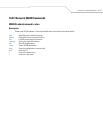
Command Line Interface Reference 10-131
Example:
admin(network.wlan)>set name 1 store
admin(network.wlan)>set name 2 backoff
admin(network.wlan)>set auth 1 kerberos
Kerberos requires WEP 104 or Keyguard. The encryption type has been changed to W
EP104.
admin(network.wlan)>set no-mu-mu 1 enable
admin(network.wlan)>show wlan 1
wlan name : store
ess identifier : 101
wlan mode : enable
enc type : wep104
auth type : kerberos
voice prioritization : enable
disallow mu to mu : enable
answer broadcast ess : disable
default mu acl mode : allow all
default ap adopt mode : allow all
multicast address 1 : 01005E000000
multicast address 2 : 09000E000000
type
<idx>
phrase/
key
Sets the CCMP key type to phrase or key for WLAN <idx>.
phrase
<idx> <phrase>
Sets the CCMP ASCII pass phrase for WLAN <idx> to
<phrase> (8–63 characters). Must be specified when type
parameter is set to phrase.
rotate-mode
<idx>
enable/
disable
Enables or disables the broadcast key rotation for WLAN
<idx>.
interval
<idx> <interval>
Sets the broadcast key rotation interval for WLAN <idx>
to <interval> (300–604800) seconds.
mixed-mode
<idx>
enable/
disable
Enables or disables mixed mode (allowing WPA-TKIP cli-
ents) for WLAN <idx>.
preauth
<idx>
enable/
disable
Enables or disables preauthentication (fast roaming) for
WLAN <idx>.
opp-pmk
<idx>
enable/
disable
Enables or disables opportunistic PMK caching (fast
roaming) for WLAN <idx>.
Note: The WEP authentication mechanism saves
up to four different keys (one for each WLAN). It
is not requirement to set all keys, but you must
associate a WLAN with the appropriate key.
wep-mcm index
<idx> <kidx>
Selects the WEP/KeyGuard key (from one of the four
potential values of <kidx> (1–4) for WLAN <idx>.
key
<idx> <kidx> <key>
Sets the WEP/KeyGuard key for key index <kidx> (1–4) for
WLAN <idx> to <key> 1 to 26 (hex digits).


















